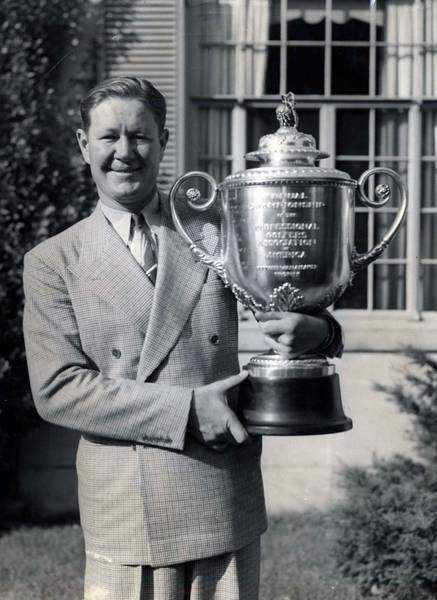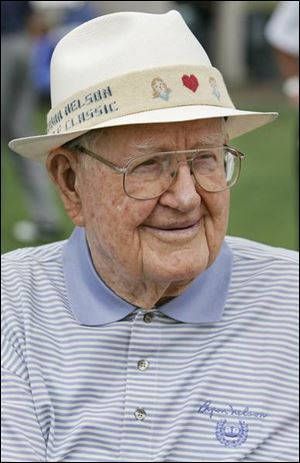
Golfing legend once was head pro at Inverness Club
9/27/2006
Byron Nelson displays his 1940 PGA trophy. He told The Blade in 2001 he considered Inverness his home course.

Byron Nelson is listed as an honorary member on the Inverness Clubmembership list.
Almost 60 years after he left his job as head golf professional at Inverness Club, Byron Nelson sat under an umbrella on the lawn behind the Augusta National clubhouse in Georgia and said he still considered the Toledo club to be his home course.
That was fine by the folks at Inverness. To this day, he is listed as an honorary member on the club's membership list.
The Inverness rolls decreased by one yesterday when Mr. Nelson, the greatest golfer of the World War II era, author of the most remarkable season in professional golf history, and the game's finest gentleman, died in Texas at the age of 94.
Mr. Nelson was the pro at Inverness from 1940-44. He signed his first contract with the club in June of 1939 and won the U.S. Open two weeks later.
Mr. Nelson maintained a PGA Tour playing schedule and won two more major championships, the 1940 PGA and the 1942 Masters, while affiliated with Inverness Club.
In 1944, Lord Byron, as he was nicknamed, won 10 pro events and finished in the top three in 11 other tournaments. He resigned from Inverness at the end of the year to devote himself to a brief, full-time tour playing career.

Byron Nelson displays his 1940 PGA trophy. He told The Blade in 2001 he considered Inverness his home course.
A year later, he compiled a playing record that has never been, and most likely never will be, duplicated. He won 18 tournaments, including 11 straight.
In a 2001 interview conducted at Augusta National, Mr. Nelson told The Blade that he believed playing the Inverness course against the club's best golfing members was a key to his tour success.
"It was such a good golf course," he said. "Still is, of course. And I still think of it as my home course after all these years. I sure do. You had to play shots uphill, downhill, over ravines, and to small, target greens with tremendous speeds.
"I would go out and play a threesome or foursome of very fine Inverness players and I'd play against their best ball. We wouldn't play for much, maybe a dollar, and I had to shoot 66 or 67 to break even. Then I'd go to the PGA [Championship] and play a match against one man and it would seem pretty simple. So there were a lot of ways that being the head professional at Inverness enhanced my playing career."
Mr. Nelson played in an era when it was not unusual for touring pros to also serve as club pros to supplement their rather meager tour earnings.
After learning the game while a caddie at Glen Garden Country Club in Fort Worth, Mr. Nelson turned professional in Nov., 1932, and took his first club job the following spring at Texarkana Golf Club. He worked for awhile at Ridgewood Country Club in New Jersey and then became head pro in 1937 at Reading (Pa.) Country Club.
He came to the attention of Cloyd Haas, an Inverness past president who was charged with hiring a new professional in 1939. Mr. Haas got his man and then sat down to write a letter to the other finalist, who was then an assistant pro at Century Country Club in White Plains, N.Y.
It began, "Dear Mr. Hogan."
Fellow Texan Ben Hogan was also a caddie at Glen Garden in the 1920s and he and Mr. Nelson would be lifelong friends and rivals whose stories intertwined until Mr. Hogan's death in 1997.
After signing his contract with Inverness and winning the 1939 U.S. Open, Mr. Nelson soon came to Toledo to compete in the old Inverness Four-Ball tournament. It was when he first met Herman Lang, who would become his assistant at Inverness in 1941. Mr. Lang would become head pro at Highland Meadows after serving in World War II and, from 1966-79, was head pro at Inverness.
"The guy was walking on water, in many people's eyes, when he arrived here after winning the Open," Mr. Lang, 92, said yesterday. "That may have been true, too, because he was a seven-day saint, a seven-day-a-week Christian, and just a wonderful person. When I worked for him in '41, he kept this jar in the pro shop. Anyone who uttered a curse word had to put 25 cents in the jar, and he would put the money in the collection plate at church the next Sunday.
"He was perhaps the most considerate and modest man I've ever known. He could teach and play the game as well as anybody. And I know he's got it made today. I'm sure nobody ever had an easier time getting into Heaven. I hope he'll save me a place."
While at Inverness, Mr. Nelson tutored Frank Stranahan, the son of wealthy club member R.A. Stranahan, who soon became the world's top-ranked amateur golfer. Mr. Nelson also joined Mr. Haas in developing the modern golf umbrella.
For many years, Mr. Nelson served as vice president of marketing for Toledo's Haas-Jordan Company. When the firm celebrated its 100th anniversary in the late 1990s, a special-edition golf umbrella with a leather handle wrap bearing Mr. Nelson's signature was manufactured in his honor.
Inverness Club's formal dining room is named in Mr. Nelson's honor, and a section of the wall in the club's mixed grill is dedicated to memorabilia from his playing career. His "player of the decade" trophy is also on display at Inverness.
The late entertainer, Bing Crosby, used to tell the story about following Mr. Nelson at the Los Angeles Open, the first PGA Tour event of 1945. Mr. Nelson was not eligible for military service because of a rare blood condition, so he and Mr. Crosby became friends while taking part in Red Cross and other war effort benefits during World War II.
"You going to go with me some?" Mr. Nelson asked him when they met near the first tee. "I'm going to follow you until I feel you've made a bad shot," the crooner replied.
Mr. Crosby followed him for the entire 18 holes and then 11 more the next day until Mr. Nelson hit a thin, 6-iron approach shot that landed in a greenside bunker. Mr. Crosby gave him a wave and walked away.
It was probably a good thing. Otherwise, Mr. Crosby would have had to follow him from city to city, tournament to tournament, because Mr. Nelson didn't hit many bad shots in 1945.
He won 18 times - 11 of those tournaments in succession - finished second seven times, posted 100 sub-par rounds out of 112 played, and set a single-season stroke average of 68.34 that was a PGA Tour record for 55 years until Tiger Woods broke it in 2000. That was the same year Mr. Woods won six straight tournaments, tying the best mark by any golfer since Mr. Nelson won 11 in a row.
The 60th anniversary of the streak was celebrated by the PGA Tour in 2005, and Mr. Woods called Mr. Nelson's accomplishment "simply incredible."
Jack Nicklaus called it "one of the greatest accomplishments in all of sports," and Arnold Palmer said that, "Byron Nelson accomplished things on the pro tour that never have been and never will be approached again."
Mr. Nelson would play full-time tour golf for just one more year. His goal was to earn enough money so that he and his first wife, Louise, could make the cash purchase of a ranch. Mr. Nelson reputedly was a meticulous record-keeper who could tell you his bank statement down to the penny. When he earned $152.50 for a 13th-place tie at the Pensacola Open early in the 1946 season he knew it gave him the final bit of escrow money he needed.
He and Louise purchased a 630-acre plot of land in Roanoke, Texas, a crossroads some 20 miles outside Fort Worth. They named it "Fairway Ranch," and he retired from tour golf at the end of that year.
Mr. Nelson lived the remainder of his life on the ranch. Louise, whom he married in 1934, died after a series of strokes in October, 1985. He is survived by his second wife, Peggy, a one-time Toledoan he married in November, 1986.
Mr. Nelson continued to play in the Masters through the mid-1960s and later served as one of the tournament's honorary starters for 20 years.
He didn't completely stop playing golf until the morning of April 5, 2001. On a crisp, sunny day, with the dew just starting to burn off the fairways, Lord Byron walked to the first tee at Augusta National for the final time.
"OK, little ball, one more time," the then-89-year-old legend said before swinging the club.
The ball didn't go far, but, as always, it landed in the fairway.
Contact Dave Hackenberg at:
dhack@theblade.com
or 419-724-6398.